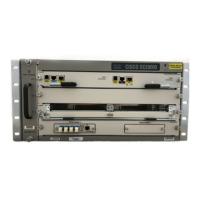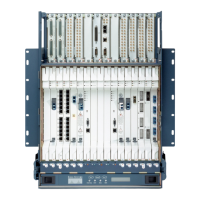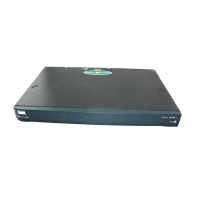5-31
Cisco SCE8000 Software Configuration Guide, Rel 3.1.6S
OL-16479-01
Chapter 5 Configuring the Management Interface and Security
Configuring and Managing the SNMP Interface
How to Configure the SCE Platform to Send Notifications to a Host (NMS)
Step 1 At the SCE(config)# prompt, type snmp-server host ip-address community-string and press Enter.
If the version is not specified, SNMPv1 is assumed.
Only one host can be specified per command. To define multiple hosts, execute one command for each
host.
Configuring the SCE Platform to Send Notifications to Multiple Hosts: Example
The following example shows how to configure the SCE platform to send SNMPv1 notifications to
several hosts.
SCE(config)#snmp-server host 10.10.10.10 mycommunity
SCE(config)#snmp-server host 20.20.20.20 mycommunity
SCE(config)#snmp-server host 30.30.30.30 mycommunity
SCE(config)#snmp-server host 40.40.40.40 mycommunity
How to Configure the SCE Platform to Stop Sending Notifications to a Host
Step 1 At the SCE(config)# prompt, type no snmp-server host ip-address and press Enter.
Configuring the SCE Platform to Stop Sending Notifications to a Host: Example
The following example shows how to remove the host with the IP Address: “192.168.0.83”.
SCE(config)#no snmp-server host 192.168.0.83
How to Configure SNMP Traps
Use this command to configure the notifications that will be sent to the defined host.
• Options, page 5-31
• How to Enable the SNMP Server to Send Authentication Failure Notifications, page 5-32
• How to Enable the SNMP Server to Send All Enterprise Notifications, page 5-32
• How to Enable the SNMP Server to Send a specific Enterprise Notification, page 5-32
• How to Restore All Notifications to the Default Status, page 5-32
Options
The following options are available:
• snmp — optional parameter that specifies that all or specific snmp traps should be enabled or
disabled.
By default, snmp traps are disabled.
snmp trap name — optional parameter that specifies a specific snmp trap that should be enabled
or disabled.
Currently the only accepted value for this parameter is Authentication .
• enterprise — optional parameter that specifies that all or specific enterprise traps should be enabled
or disabled.
By default, enterprise traps are enabled.

